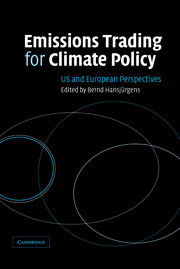Book contents
- Frontmatter
- Contents
- List of figures
- List of tables
- List of contributors
- Preface
- List of abbreviations
- 1 Introduction
- Part 1 Regulatory instruments for climate policy: theoretical aspects
- Part 2 The US approach to pollution control: lessons for climate policy
- Part 3 European policies to control greenhouse gases: the EU directive on emissions trading
- 14 Concluding observations
- Index
- References
14 - Concluding observations
Published online by Cambridge University Press: 22 September 2009
- Frontmatter
- Contents
- List of figures
- List of tables
- List of contributors
- Preface
- List of abbreviations
- 1 Introduction
- Part 1 Regulatory instruments for climate policy: theoretical aspects
- Part 2 The US approach to pollution control: lessons for climate policy
- Part 3 European policies to control greenhouse gases: the EU directive on emissions trading
- 14 Concluding observations
- Index
- References
Summary
The Kyoto Protocol of 1997 brought climate policy onto the national and international agenda. To reach the Kyoto greenhouse gas emissions target of an overall reduction of 5 percent (from 1990 levels) among developed countries is, however, only a first step toward stabilizing the climate at a non-deleterious level. In the long term a much larger reduction of global emissions will be needed. Economists doubt that the goals of climate protection can be achieved in the frame of a “win-win” scenario, i.e. with gains for the economy and the environment, or without additional costs for society. As climate policy rarely provides a free lunch, the control of greenhouse gases is associated with costs and, thus, is likely to be a quite expensive task. It is therefore crucial to search for cost-effective policies for climate protection.
The analysis in this book indicates that tradable permits are the most suitable instrument for climate protection. Emissions trading has the potential to control greenhouse gas emissions at the lowest economic costs. The emission cap safeguards the environmental goals, while trading is a highly flexible and dynamic solution. It is also easily enforceable at the firm level: the monitoring and enforcement of an emissions trading scheme guarantees 100 percent compliance. This is almost impossible through command-and-control regulations, which still dominate in most fields of environmental policy. Emissions trading also changes the relationship between the regulator and the emitting firm.
- Type
- Chapter
- Information
- Emissions Trading for Climate PolicyUS and European Perspectives, pp. 222 - 237Publisher: Cambridge University PressPrint publication year: 2005
References
- 1
- Cited by



